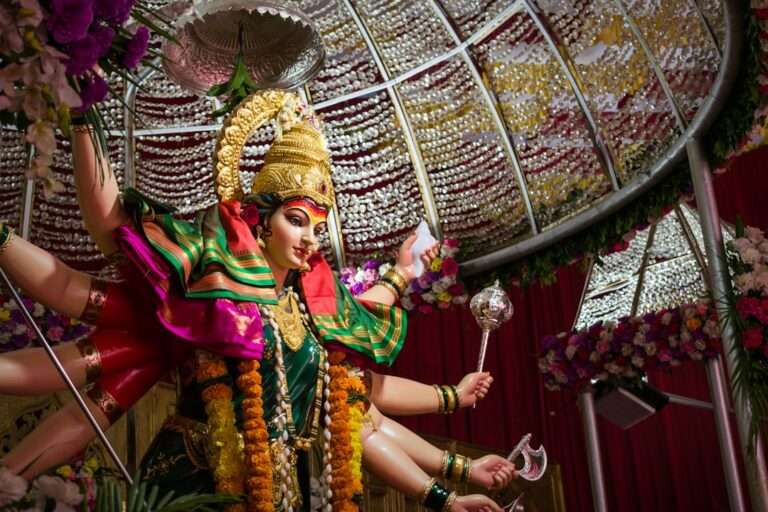What is the meaning of the dragon symbol in Chinese culture?

The dragon occupies a prominent position in Chinese culture, symbolizing power, strength, and good fortune. As one of the most recognizable and enduring icons in Chinese mythology and folklore, its influence permeates various aspects of Chinese society, including art, architecture, festivals, and traditions. Deeply embedded in the Chinese collective consciousness, the dragon is revered as an emblem of prosperity and auspiciousness.
Its cultural significance can be traced back to ancient times and continues to maintain a strong presence in contemporary Chinese culture. Historically, the dragon has been closely associated with imperial authority and was considered a symbol of the emperor. It is widely believed to bestow blessings and protection, leading to the widespread use of dragon imagery in Chinese homes and businesses.
The dragon’s cultural impact extends beyond China’s borders, as it has gained popularity as a symbol in Western cultures as well. The dragon’s lasting importance in Chinese culture makes it a compelling subject for study, offering valuable insights into the rich historical and traditional heritage of the Chinese people.
Key Takeaways
- The dragon is a powerful and revered symbol in Chinese culture, representing strength, power, and good fortune.
- The dragon has deep historical and mythological origins in Chinese culture, with stories of its significance dating back thousands of years.
- In Chinese art and architecture, the dragon is often depicted as a symbol of protection and prosperity, and is commonly found in traditional designs.
- The dragon plays a significant role in Chinese festivals and traditions, with dragon dances and performances being a common sight during celebrations.
- The dragon has long been associated with power and imperial authority in Chinese history, often being used as a symbol by emperors to represent their rule.
- The dragon symbol continues to be popular in modern culture, with its imagery being used in various forms of media and entertainment.
- The enduring significance of the dragon in Chinese culture is a testament to its lasting impact and importance in the country’s traditions and beliefs.
Historical Origins and Mythological Significance of the Dragon
The Dragon’s Divine Significance
In ancient Chinese folklore, the dragon was revered as a divine creature that controlled the elements and brought rain for the crops. It was also believed to have the power to ward off evil spirits and bring good fortune to those who worshipped it.
Association with the Emperor and Yin-Yang
The dragon was often associated with the emperor, who was considered to be the “Son of Heaven” and was believed to have a divine connection to the dragon. The dragon’s mythological significance can be seen in various ancient texts and artworks, where it is depicted as a powerful and majestic creature with the ability to shape-shift and control the forces of nature. The dragon was also associated with the concept of yin and yang, representing the balance between opposing forces in the universe.
Enduring Popularity in Chinese Culture
Its mythical origins have contributed to its enduring popularity in Chinese culture, where it continues to be revered as a symbol of strength, power, and good fortune.
The Symbolism of the Dragon in Chinese Art and Architecture

The dragon has been a prominent motif in Chinese art and architecture for centuries, with its image adorning everything from pottery and paintings to temples and palaces. In Chinese art, the dragon is often depicted as a fearsome yet benevolent creature, with its sinuous body and powerful claws symbolizing strength and protection. Its image can be found on a wide range of objects, including silk robes, porcelain vases, and jade carvings, where it is often portrayed in vibrant colors and intricate detail.
In Chinese architecture, the dragon is a common decorative element, with its image carved into the eaves of temples and palaces as a symbol of protection and good fortune. The dragon’s presence in Chinese art and architecture reflects its enduring significance in Chinese culture, where it is revered as a symbol of power, strength, and prosperity. Its influence can also be seen in traditional Chinese martial arts, where the movements of certain styles are inspired by the fluidity and grace of the dragon.
The Dragon in Chinese Festivals and Traditions
The dragon plays a central role in many Chinese festivals and traditions, where it is celebrated as a symbol of good luck and prosperity. One of the most famous examples is the Dragon Boat Festival, which is held annually to commemorate the death of the ancient poet Qu Yuan. During this festival, colorful dragon boats race along rivers and lakes, accompanied by the rhythmic beating of drums and the cheers of spectators.
The dragon boat races are believed to bring good luck and ward off evil spirits, making them an important part of Chinese cultural heritage. The dragon is also a prominent feature in traditional Chinese New Year celebrations, where dragon dances are performed to usher in good fortune for the coming year. These elaborate dances involve performers manipulating a long dragon puppet through the streets, accompanied by the sounds of drums, cymbals, and gongs.
The spectacle of the dragon dance is believed to bring blessings and prosperity to the community, making it an integral part of Chinese New Year festivities.
The Dragon as a Symbol of Power and Imperial Authority
In Chinese culture, the dragon has long been associated with power and imperial authority, making it an important symbol in the context of governance and leadership. The dragon was believed to be the emblem of the emperor, who was considered to have a divine connection to the mythical creature. The emperor’s throne was often referred to as the “dragon throne,” and his robes were adorned with images of dragons as a symbol of his authority.
The dragon’s association with power can also be seen in Chinese martial arts, where certain styles are inspired by the movements and characteristics of the dragon. These martial arts emphasize agility, grace, and strength, reflecting the qualities traditionally associated with the dragon. The dragon’s influence on Chinese society extends beyond symbolism, as it continues to inspire reverence and awe as a symbol of strength and authority.
Modern Interpretations and Popularity of the Dragon Symbol

The Dragon’s Enduring Popularity
Its lasting popularity stems from its status as a symbol of strength, power, and good fortune, making it a coveted motif for both traditional and contemporary designs. The dragon’s influence can also be seen in popular culture, where it has been featured in numerous films, television shows, and video games as a powerful and majestic creature.
A Universal Symbol
In addition to its popularity in China, the dragon has also become a widely recognized symbol in Western culture, where it is often associated with mystery, magic, and adventure. Its image can be found in Western literature, art, and fashion, where it is often portrayed as a fearsome yet noble creature.
Transcending Cultural Boundaries
The dragon’s enduring appeal transcends cultural boundaries, making it a universal symbol that continues to captivate people around the world.
The Enduring Significance of the Dragon in Chinese Culture
The dragon holds a special place in Chinese culture as a symbol of power, strength, and good fortune. Its mythological origins date back thousands of years, and its influence can be seen in various aspects of Chinese society, from art and architecture to festivals and traditions. The dragon’s association with imperial authority reflects its status as a revered symbol of governance and leadership, while its popularity in modern culture reflects its enduring appeal as a universal symbol of strength and prosperity.
The dragon’s significance in Chinese culture offers insight into the rich history and traditions of the Chinese people, where it continues to inspire reverence and awe as a symbol of strength and authority. Its enduring popularity reflects its status as a universal symbol that transcends cultural boundaries, making it a timeless emblem that continues to captivate people around the world. As one of the most iconic symbols in Chinese mythology and folklore, the dragon remains an enduring symbol that represents the rich cultural heritage of China.
FAQs
What is the dragon symbol in Chinese culture?
The dragon is a powerful and benevolent symbol in Chinese culture, representing strength, power, and good luck. It is often associated with the emperor and is a symbol of imperial power.
What does the dragon symbolize in Chinese culture?
In Chinese culture, the dragon symbolizes power, strength, and good fortune. It is also associated with the elements of water and air, and is believed to bring rain and prosperity.
Is the dragon a positive or negative symbol in Chinese culture?
The dragon is a positive symbol in Chinese culture, representing good luck, strength, and power. It is not associated with evil or malevolence.
How is the dragon symbol used in Chinese culture?
The dragon symbol is used in various aspects of Chinese culture, including art, architecture, clothing, and festivals. It is often depicted in traditional Chinese paintings, sculptures, and embroidery.
What is the significance of the dragon symbol in Chinese festivals?
The dragon is a central figure in many Chinese festivals, including the Dragon Boat Festival and Chinese New Year. During these festivals, dragon dances are performed to bring good luck and prosperity for the coming year.





